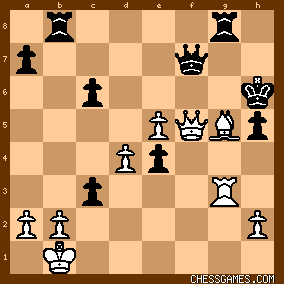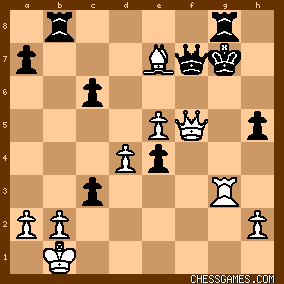|
< Earlier Kibitzing · PAGE 3 OF 3 ·
Later Kibitzing> |
| Feb-16-12 | | SuperPatzer77: Black resigns - see diagram below:

click for larger view32. Bg5+! Kg7, 33. Be7+! (discovered check - better than 33. Bh6+ ) Kh6, 34. Qxf7 Rxb2+, 35. Kc1 Rxg3, 36. Qf4+ - see below: a) 36...Rg5, 37. Bxg5+ Kg6, 38. Qf6+ Kh7, 39. Qf7+ Kh8, 40. Bf6# b) 36...Kg7, 37. Qf6+ Kh7, 38. hxg3 (White keeps attacking the Black King)  1-0
SuperPatzer77 |
|
| Feb-16-12 | | Gilmoy: I followed Phony's thinking: first check the Anastasia (fizzle ~20 sec), then <29.Rxh5+> as clearance (few more sec). <numerous: 32...Kg7 33.Bh6+ Kxh6 34.Qxf7> Also my first thought (once I got there): deflection is a tyro theme. But then I quickly spotted the even stronger principle of <taking flight squares>: 33.Be7+ prevents Kf8, Black must abandon Q, White keeps the B. Sit on hands, look for better! |
|
| Feb-16-12 | | SuperPatzer77: <Gilmoy: I followed Phony's thinking: first check the Anastasia (fizzle ~20 sec), then <29.Rxh5+> as clearance (few more sec).
<numerous: 32...Kg7 33.Bh6+ Kxh6 34.Qxf7> Also my first thought (once I got there): deflection is a tyro theme. But then I quickly spotted the even stronger principle of <taking flight squares>: 33.Be7+ prevents Kf8, Black must abandon Q, White keeps the B. Sit on hands, look for better!> <Gilmoy> You're dadgummed right about that. Like you said, White keeps his own bishop and looks for better. Take a look at my commentary SuperPatzer77 |
|
| Feb-16-12 | | Nemesistic: Really easy for a Thursday, then again i may be wrong but i'd go like this 29.Rxh5+ ...gxh(forced) 30.Qf4+ ...Kh7 31.Qxf5+ ...Rg6 31.Qh5+,blavks Rook is pinned to its hanging Queen so cant block the check with the Rook and from there its kind of hard for white to lose, up in material, can probably afford to let black play Rxb2+ at some point without worries too.. The puzzles are easy this week, right?? |
|
Feb-16-12
 | | OhioChessFan: Knowing it was a puzzle pushed me to Rxh5 when I might have found the more thematic e6. I find sidelines interesting sometimes. If you don't check Black to oblivion or get his Queen off the board, it's incumbent to capture the c3 Pawn. Here's one try: 29. Rxh5+ gxh5 30. Qf4+ Kh7 31. Qxf5+ Kh6 32. <Qf4+> Kh7 33. Qxe4+ Rg6 34. Rxc3 
click for larger viewThen 34...Qd5 for sure and the rest is above my pay grade. |
|
| Feb-16-12 | | paire: I got it! :) Nice puzzle |
|
| Feb-16-12 | | Crispy Seagull: I did see the initial rook sac, and I could see the potential that the move opened up, but I could not see all the way through to the get mated/lose the queen position. |
|
| Feb-16-12 | | Cibator: Took me longer than it should have till I realised the exchange-sac leaves the Pf5 unprotected against the WQ. Straightforward after that. |
|
Feb-16-12
 | | doubledrooks: 29. Rxh5+ allows the White queen to reach f4 with impunity and unleashes a winning attack. For example: 29...gxh5 30. Qf4+ Kh7 31. Qxf5+ Kh6 32. Bg5+ Kg7 33. Bh6+ Kxh6 34. Qxf7 Rxb2+ 35. Kc1  |
|
| Feb-16-12 | | LoveThatJoker: Awesome. A Chigorin puzzle!
I'm seeing that White wins by firstly sacrficing the exchange and secondly delivering a series of deadly checks: 29. Rxh5+ gxh5 30. Qf4+ Kh7 31. Qxf5+ Kh6 (31...Rg6 32. Qxh5+ wins) 32. Bg5+ Rxg5 (33...Kg7 34. Bh6+ and Black loses the Q) 33. Qxf7 Rxb2+ 34. Kc1  LTJ |
|
| Feb-16-12 | | Memethecat: <sethoflagos> I've started using <dzeicial>s idea. Open your notepad on windows & write your analysis on there, it's great way to keep track of your thoughts. It has helped me SOOOO much. Last week I got thur,fri & sat correct, very rare for me but hopefully it will become more frequent. |
|
| Feb-16-12 | | Memethecat: <zb2cr I can't maintain a full picture of the board in my head as I analyze beyond a certain point and make mistakes based on a fuzzy picture of the board.> Well you've come to right place....Welcome to the club. 8>) |
|
| Feb-16-12 | | jackpawn: Wow, I got it, but took longer than I would have liked (several minutes). With all the white pieces surrounding the black king you know there must be a combination. The problem is there are so many candidate lines. Followed a couple of dead ends before taking the right path. |
|
| Feb-16-12 | | sethoflagos: <Memethecat:> It's more fun with Mrs Seth and a biro. But that's weekends only. |
|
| Feb-16-12 | | Gato: According to my soft ,it seems that 29.e6 is better (mat in 14). |
|
Feb-16-12
 | | Jimfromprovidence: Wow! Depending on whose turn it is, it's forced mate for either side in the puzzle position.

click for larger view The 29 e6 Rxb2+ line is particularly compelling to analyze. 
click for larger view |
|
| Feb-16-12 | | dzechiel: White to move (29?). Black is up a pawn. "Medium." Looked at this one far too long. The threat of 29...Rxb2+ finally focused me on forcing moves, particularly checks. That's when I finally noticed that black's f-pawn would be unprotected after... 29 Rxh5+ gxh5 30 Qf4+ Kh7
and that white could now play
31 Qxf5+ Kh6
Not 31...Rg6 32 Qxh5+, and black must lose the queen (on 32...Rh6 33 Qxf7+) or be checkmated (32...Kg7 33 Qh8#). 32 Bg5+ Kg7 33 Bh6+
and white wins the black queen for a rook.
Time to check. |
|
| Feb-16-12 | | SuperPatzer77: <LoveThatJoker>, <gofer>, <abg2002> White to move and win - see diagram below:

click for larger viewNow Which one is better? 33. Bh6+ or 33. Be7+ (discovered check) Compare diagram #1 with diagram #2 below: Which one is better? Diagram #1

click for larger view Diagram #2

click for larger viewI believe 33. Bh6+ is not a really good move but 33. Be7+! is much better than 33. Bh6+. White can win the Black queen and keep his own bishop. White has strong mating attacks on Black with the White queen and the White bishop. SuperPatzer77 |
|
| Feb-16-12 | | newton296: thanks to the fact that black threatens mate I fiugred I needed alot of checks so Rxh5+ was logical start. |
|
| Feb-16-12 | | Patriot: <SuperPatzer77> <I believe 33. Bh6+ is not a really good move but 33. Be7+! is much better than 33. Bh6+.> After seeing it, 33.Be7+ does look much better. But 33.Bh6+ is not a really good move?? It is absolutely winning and that is "good enough" when analyzing ahead. You might be surprised what Houdini says is the best move (I was!). Here's the winning lines:
click for larger viewAnalysis by Houdini 1.5a x64:
1.  (#11): 1.Bf4+ Kh8 2.Qxf7 Rxg3 3.hxg3 Rxb2+ 4.Kc1 Rf2 5.e6 Rf1+ 6.Kc2 Rf2+ 7.Kb3 Rb2+ 8.Kxc3 Rb5 9.e7 Rc5+ 10.dxc5 a5 11.e8Q# (#11): 1.Bf4+ Kh8 2.Qxf7 Rxg3 3.hxg3 Rxb2+ 4.Kc1 Rf2 5.e6 Rf1+ 6.Kc2 Rf2+ 7.Kb3 Rb2+ 8.Kxc3 Rb5 9.e7 Rc5+ 10.dxc5 a5 11.e8Q# 2.  (#12): 1.Be7+ Kh6 2.Qxf7 Rxg3 3.hxg3 Rb7 4.e6 Rxb2+ 5.Kc1 Rb7 6.Qf4+ Kh7 7.Qf5+ Kh8 8.Bf6+ Kg8 9.Qg5+ Kf8 10.Qh6+ Rg7 11.Qxg7+ Ke8 (#12): 1.Be7+ Kh6 2.Qxf7 Rxg3 3.hxg3 Rb7 4.e6 Rxb2+ 5.Kc1 Rb7 6.Qf4+ Kh7 7.Qf5+ Kh8 8.Bf6+ Kg8 9.Qg5+ Kf8 10.Qh6+ Rg7 11.Qxg7+ Ke8 3.  (14.65): 1.Bh6+ Kxh6 2.Qxf7 Rxg3 3.hxg3 e3 4.Qf4+ Kh7 5.Qe4+ Kg7 6.Qxe3 Rf8 7.Qg5+ Kh7 8.Qxh5+ Kg7 9.bxc3 Rf1+ 10.Kb2 a5 11.Qg4+ Kf7 12.Qd7+ Kg6 13.Qxc6+ Kg5 14.e6 Re1 15.Qc5+ Kg6 16.d5 Re2+ (14.65): 1.Bh6+ Kxh6 2.Qxf7 Rxg3 3.hxg3 e3 4.Qf4+ Kh7 5.Qe4+ Kg7 6.Qxe3 Rf8 7.Qg5+ Kh7 8.Qxh5+ Kg7 9.bxc3 Rf1+ 10.Kb2 a5 11.Qg4+ Kf7 12.Qd7+ Kg6 13.Qxc6+ Kg5 14.e6 Re1 15.Qc5+ Kg6 16.d5 Re2+ I know what you are thinking. Why not 1.Bf4+ Kf8? Houdini says 2.e6! and if 2...Qxf4 3.Bd6+ Ke8 4.Rxg8+ Qf8 5.Rxf8# |
|
| Feb-16-12 | | SuperPatzer77: <Patriot> 33. Be7+ and 33. Bf4+ (best one) can lead to mounting the mating attack on the Black King. IMHO, 33. Bh6+ may lead to a prolonged game because the White Queen alone cannot mate the Black King. White needs to keep his own bishop so, Q + B can mate the enemy king like these two lines shown by Houdini - 33. Bf4+ and 33. Be7+ 33. Bf4+ and 33. Be7+ are good because White doesn't throw away his own bishop. SuperPatzer77 |
|
| Feb-16-12 | | VincentL: "Medium".
After a little thought I think this must start 29. Rxh5+. Then 29.....gxh5 30. Qf4+ Kh7
31. Qxf5+ Kh6 32. Bg5+ Rxg5 33. Qxf7 and white emerges with a material advantage of
Q for R. Or 32.....Kg7 33. Bh6+ Kh8 34. Qxf7 and white has Q + B for R. If 31.....Rg6 32. Qxh5+ Kg8 33. Qh8#.
If 31.....Qg6 32. Rxg6 Rxg6 33. Qxh5+ Rh6 34. Qf7#. Or 33.... Kg8 34. Qxg6+ Kf8 35. Qg7+ Ke8 36. Qe7# Finally after 30.....Rg5 31. Qxg5+ Kh7 32. Qxf5+ Kh6 33. Bg5+ Kg7 34. Bh6+ Kxh6 35. Qxf7
leaving white a queen up.
Let´s check. |
|
| Feb-16-12 | | Patriot: <SuperPatzer77> It may be a longer game but certainly a trivial win. I played it against Houdini, not concerned about sub-optimal moves and even traded the queen for rook after I snagged enough pawns to have an easily winning K&P endgame. It took 31 moves until mate. Time used: 56 seconds. I understand your point though for the sake of learning how to make better moves and agree on that point. However for the sake of becoming a better analyst, it is good to develop a sense of when to stop analyzing. I would bet many GM's use this type of approach and the many brilliant combinations were not calculated all the way through, but just enough to know they were on the right track. The rest is played out (unless their opponent resigns) and many players examining the game think they had foreseen the whole thing. |
|
Feb-16-12
 | | gawain: I can't see anything promising except 29 Rxh5+ gxh5 30 Qxf4+ but this looks messy to me. Checking... Oh, I did not see White's 32nd move. |
|
Feb-17-12
 | | FSR: 29.Rxh5+! gxh5 30.Qf4+ Kh7 31.Qxf5+ Kh6 (immediately losing are 31...Rg6 32.Qxh5+ and 31...Qg6 32.Rxg6 Rxg6 33.Qxh5+ Rh6 34.Qf7#) 32.Bg5+ Kh6 (32...Rxg5 33.Qxf7) 33.Bh6+ Kxh6 34.Qxf7 Rxb2+ 35.Kc1  |
|
 |
 |
|
< Earlier Kibitzing · PAGE 3 OF 3 ·
Later Kibitzing> |





